Physical Address
304 North Cardinal St.
Dorchester Center, MA 02124
Physical Address
304 North Cardinal St.
Dorchester Center, MA 02124
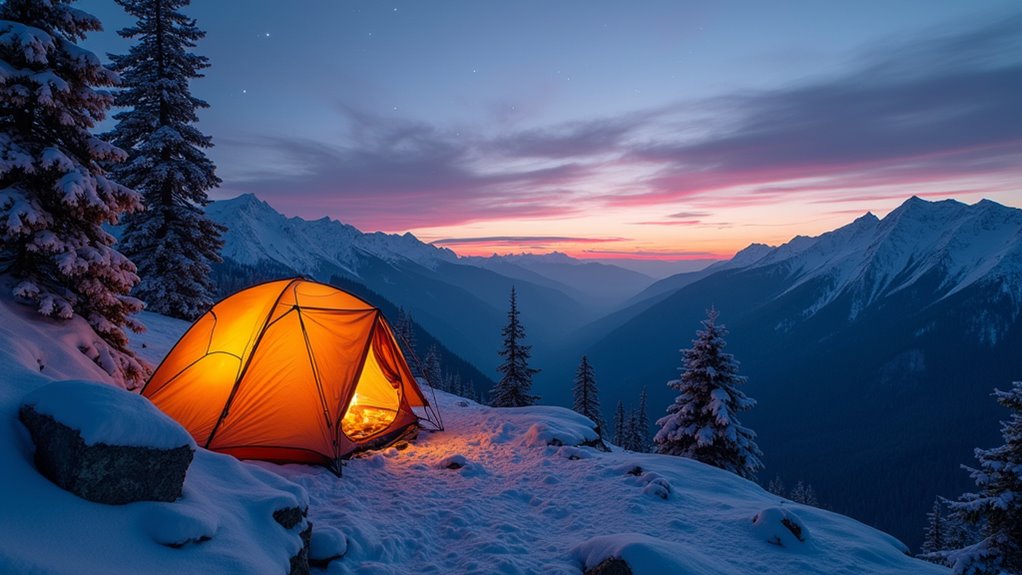
In search of winter camping bliss? These 11 spectacular destinations offer serene landscapes and perfect February weather for outdoor adventures.
You’ll find February’s mild temperatures and clear skies create perfect conditions for winter camping across America’s most stunning landscapes. From the sacred red rocks of Monument Valley to the stark beauty of Death Valley, these destinations offer a peaceful escape from crowded summer months. Whether you’re seeking solitude under starlit desert skies or coastal views from Santa Catalina Island, these 11 remarkable camping spots will help you discover winter’s hidden outdoor potential.
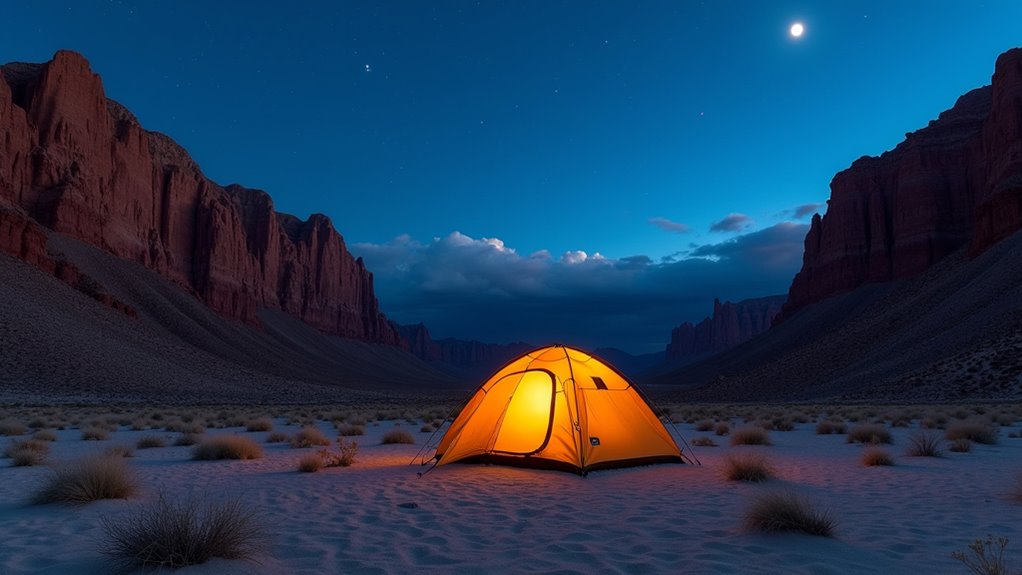
While many consider Death Valley a forbidding summer destination, February transforms this national park into an ideal winter camping spot with daytime temperatures ranging from 60°F to 80°F.
You’ll find well-developed options like Furnace Creek Campground, which offers potable water and flush toilets, or Texas Springs Campground, known for its scenic views. At the higher elevation sites, like Wildrose and Mahogany Flat campgrounds, snow is possible during winter months.
Pack cold-weather gear, as nighttime temperatures can drop below freezing, especially at higher elevations. Your tent and sleeping bag should be rated for temperatures below 32°F.
Despite Death Valley’s daytime warmth, winter nights demand serious cold-weather preparation, with temperatures plummeting below freezing in elevated areas.
Bring at least one gallon of water per person daily and prepare for limited cell service. February’s smaller crowds mean you’ll enjoy peaceful exploration of Badwater Basin and Zabriskie Point.
For backcountry camping, you’ll need a high-clearance 4×4 vehicle and must follow strict pack-in, pack-out policies.
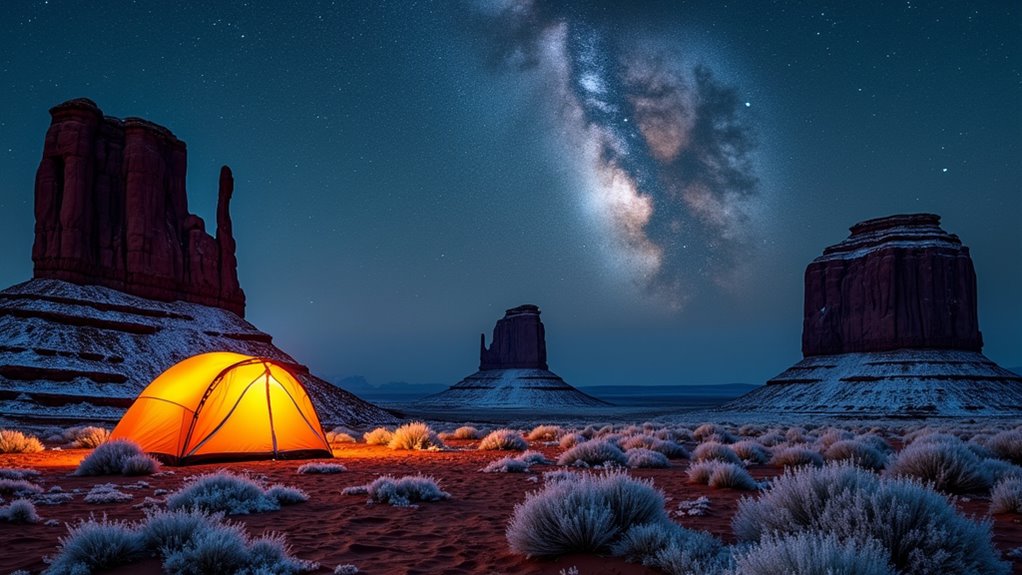
Though most visitors flock to Monument Valley in summer, February offers a uniquely serene experience at this sacred Navajo landscape.
You’ll find comfortable daytime temperatures and fewer crowds at The View Campground, where both RV and tent sites provide stunning views of the iconic Mittens buttes.
The expansive 91,696 acre park stretches across the Arizona-Utah border, offering endless opportunities for scenic exploration.
Winter nights get cold, so pack accordingly for your stay. RV sites are dry camping only, limited to 24-foot vehicles, while wilderness tent sites sit dramatically along the cliffside.
You’ll have access to restrooms, showers, and charging stations, though campfires aren’t permitted.
The real magic happens after sunset. With minimal light pollution, the winter sky reveals an exceptional display of stars.
Remember to follow proper RV camping etiquette to preserve the sacred nature of this Navajo site.
You can easily combine your stay with visits to nearby attractions like Four Corners Monument or plan day trips to Zion and Arches National Parks.
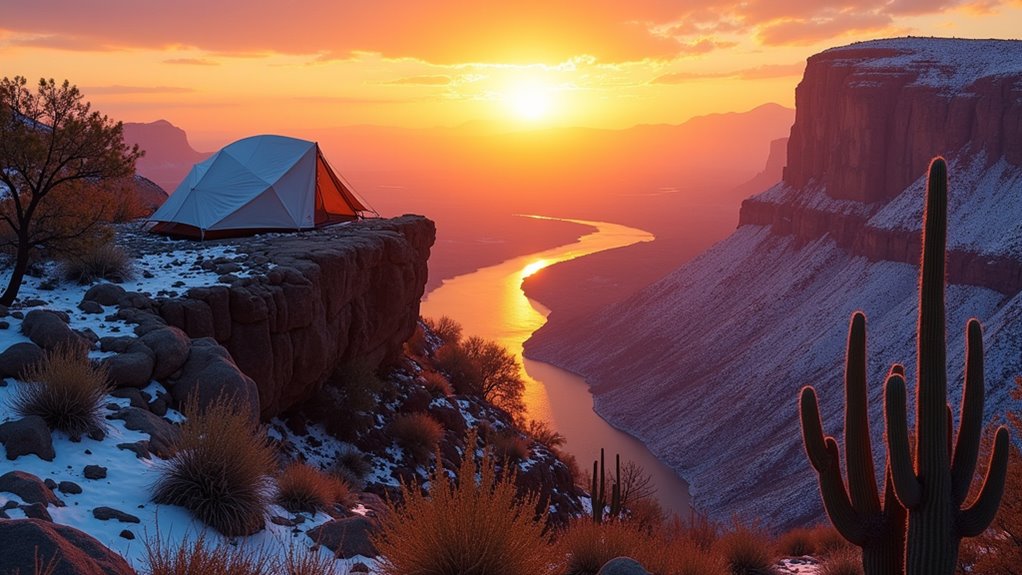
As winter visitors seek refuge from northern climates, Big Bend National Park beckons with its vast Chihuahuan Desert landscape and mild February temperatures.
You’ll find daytime highs in the mid-70s°F, though nights can dip into the 30s°F, so pack warm layers and a winterized sleeping bag.
You’ve got several camping options: Rio Grande Village RV Campground offers full hookups, while Chisos Basin, Cottonwood, and Rio Grande Village welcome tent campers and small RVs.
Book early – spots fill quickly from January through April. You’re limited to 14 nights total during peak season.
Make the most of winter’s comfortable weather by hiking Lost Mine Trail, exploring Santa Elena Canyon, or taking a dip in the Rio Grande hot springs. The clear winter nights create perfect conditions for stargazing in this dark sky paradise.
Don’t forget to stock up on supplies before arriving – services are limited in this remote wilderness.
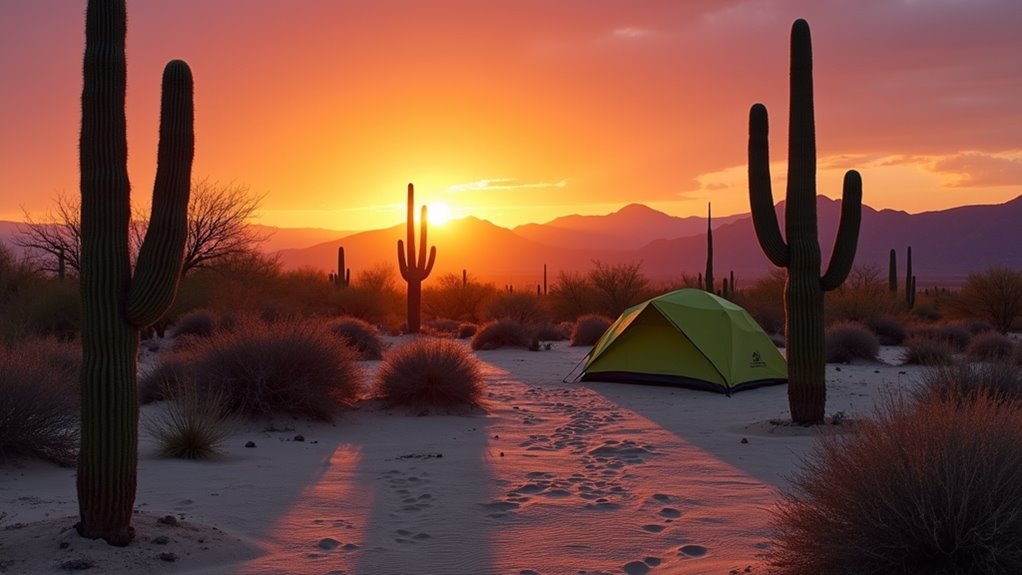
Moving west from Texas’s desert expanse, you’ll discover another winter camping gem in southwestern Arizona. Organ Pipe Cactus National Monument offers prime camping from December through February, when temperatures remain mild and comfortable.
You can set up camp at Twin Peaks Campground for $20 per night, where you’ll need to be self-sufficient despite basic amenities like potable water. The campground’s generous 208 camping sites accommodate both tent campers and RVers looking to explore the desert. Make your reservations up to six months in advance through Recreation.gov, especially during the busy winter season.
While RV hook-ups aren’t available, there’s a dump station on-site.
From your campsite, you’ll have access to hiking trails and scenic drives through the UNESCO biosphere reserve. The location’s minimal light pollution creates perfect conditions for stargazing, while the diverse desert landscape provides excellent wildlife viewing opportunities.
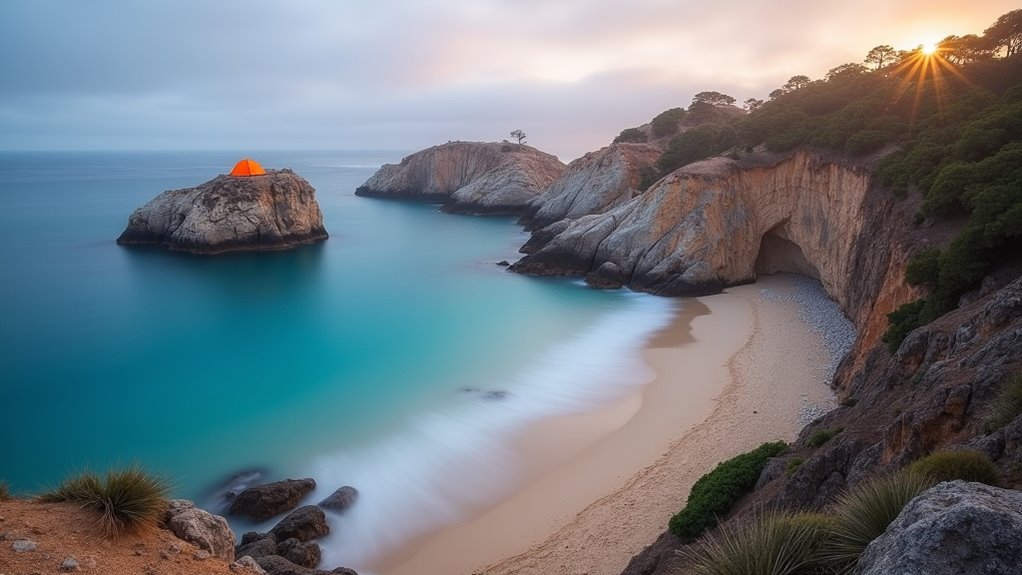
Just off the coast of Southern California, Santa Catalina Island provides an exceptional winter camping destination with seventeen primitive boat-in sites and multiple developed campgrounds along its secluded beaches.
Santa Catalina Island beckons winter adventurers with pristine boat-in campsites and developed beach campgrounds just minutes from Southern California’s coast.
You’ll find boat-in sites like Ripper’s Cove and Paradise Cove accessible only by kayak or boat, requiring you to pack portable restrooms and cooking equipment. Coin-operated showers are available at Hermit Gulch, while Two Harbors, Little Harbor, and Black Jack offer outdoor cold water showers.
For more amenities, head to Little Harbor Campground’s 23 beachfront sites or Two Harbors Campground’s 48 sites with fire pits and picnic tables.
February’s mild temperatures and reduced crowds make winter camping ideal. You’ll experience clearer night skies for stargazing and better wildlife viewing opportunities along the shoreline.
Remember to follow Leave No Trace principles, especially at primitive sites where there aren’t any facilities.
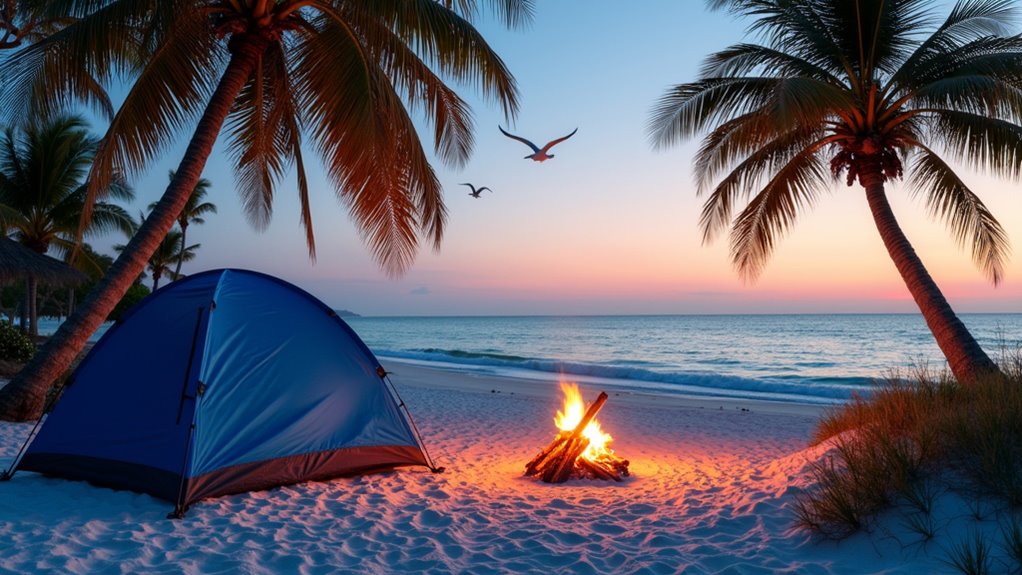
While Santa Catalina Island offers West Coast winter camping, Florida’s Siesta Key provides an equally compelling destination on the opposite coast. At Turtle Beach Campground, you’ll find 39 intimate camping sites with direct access to some of America’s most pristine white-sand beaches. Located near TripAdvisor’s #1 Beach in the United States, the campground offers unparalleled coastal access.
The campground’s recent updates include portable restrooms and showers, though you’ll need to plan around the no-pets policy.
For alternative camping experiences, consider nearby Myakka River State Park for hiking trails and airboat tours, or Royal Coachman RV Park for resort-style amenities.
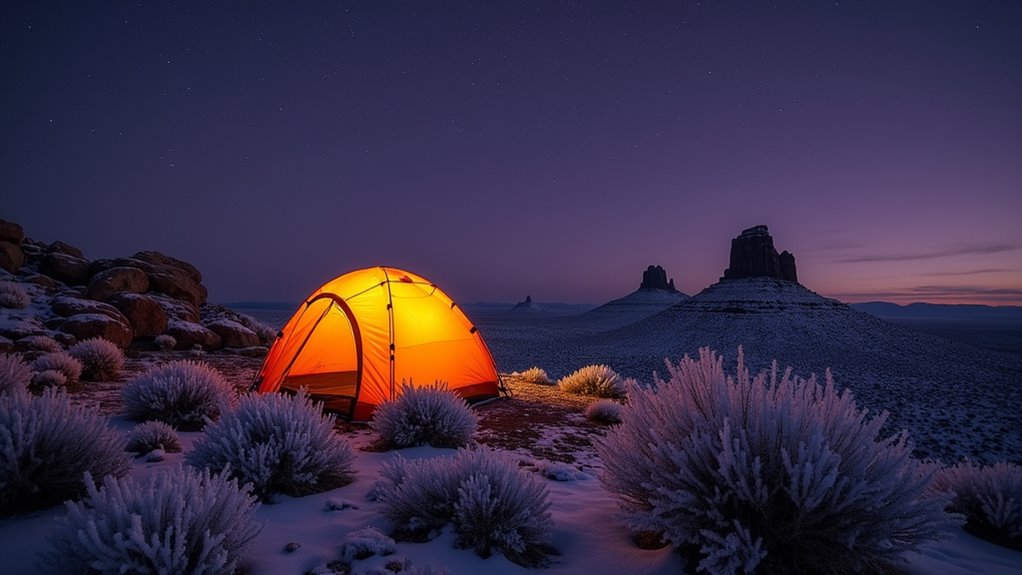
For adventurers seeking true solitude beyond Florida’s coastal comforts, Texas’ largest state park beckons with a different kind of winter camping experience.
Big Bend Ranch’s 238 miles of trails and 70 miles of dirt roads open up a vast wilderness of canyons, desert landscapes, and Rio Grande corridors.
You’ll find February’s weather surprisingly agreeable, with daytime highs in the 70s, though nights can approach freezing. Visitors can enjoy the iconic Texas blooming bluebonnets that paint the landscape in early spring.
The park’s diverse camping options include drive-up primitive sites, hike-in spots, and equestrian areas, all requiring reservations.
Pack layers and plenty of water, even in winter.
Take advantage of prime conditions for hiking, mountain biking, and paddling.
As an International Dark Sky Park, you’ll discover exceptional stargazing opportunities.
Just remember: high-clearance vehicles are essential for accessing many areas.
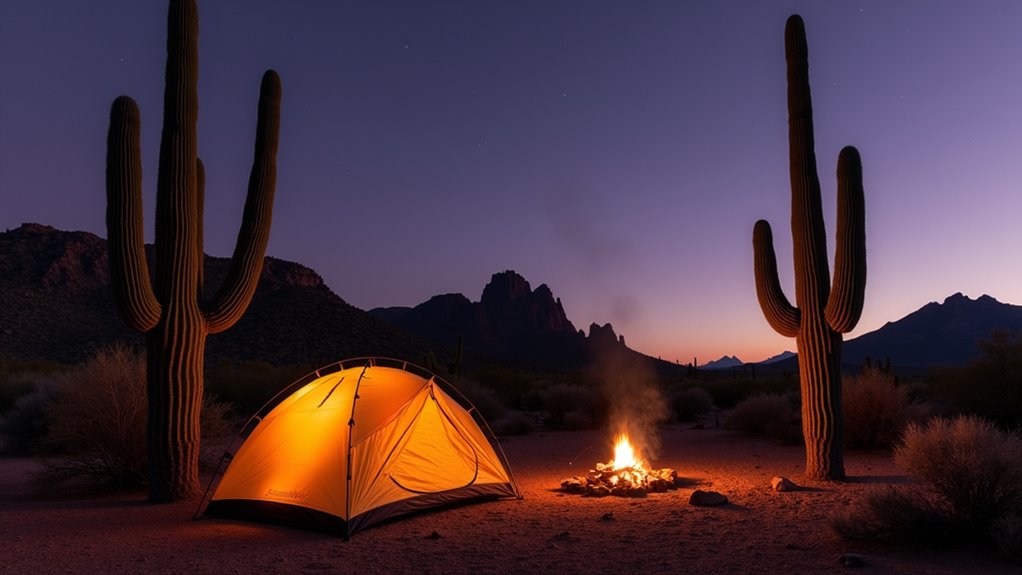
Nestled within Organ Pipe Cactus National Monument, Twin Peaks Campground offers an ideal winter retreat in southern Arizona’s Sonoran Desert. Just 1.5 miles from the Kris Eggle Visitor Center, you’ll find both tent and RV sites available by reservation only. Visitors can explore exhibits and join ranger-led programs at the nearby amphitheater.
While amenities are primitive, the stunning mountain views and serene desert environment make Twin Peaks an unforgettable winter camping destination.
Remember to book through Recreation.gov and check weather forecasts before arrival.
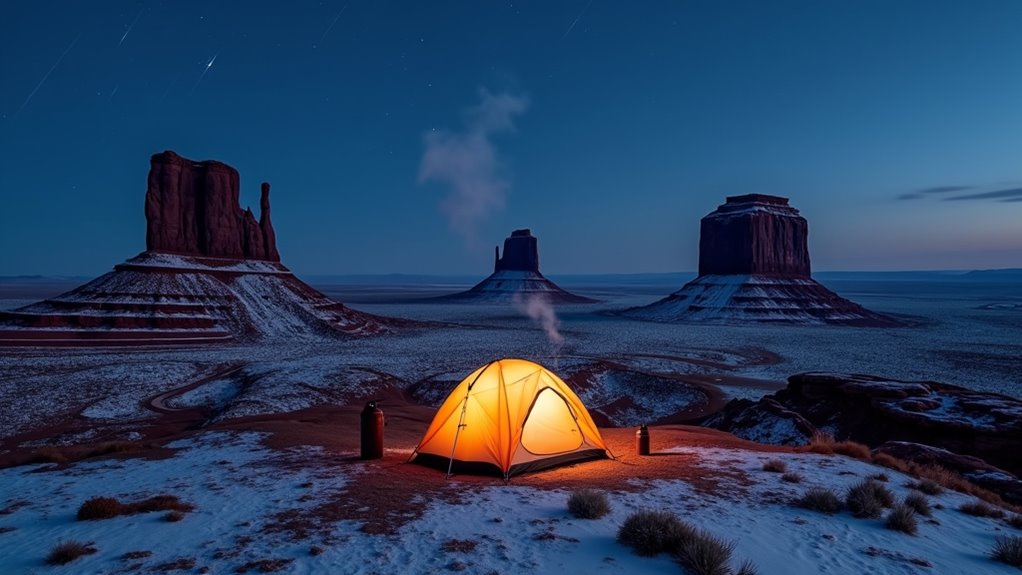
Perched on the edge of Monument Valley Navajo Tribal Park, The View Campground lives up to its name with panoramic vistas of the Southwest’s most iconic red rock formations.
You’ll find wilderness tent sites (max 5′ x 8′), dry RV spots for vehicles up to 24 feet, and valley rim cabins offering direct sunrise and sunset views. The campground provides clean restrooms, showers, picnic tables, and fire circles, plus WiFi and a dump station for RV campers. The wilderness campsites are considered to offer some of the best views worldwide.
From your base camp, you can explore the Wildcat Trail on foot, join guided Jeep tours, or venture into the tribal park for cultural experiences and ruin viewing. The location’s spectacular scenery makes it perfect for photography, especially during golden hours.
While RV sites can feel tight during peak times, the helpful staff and pristine facilities guarantee a comfortable stay.
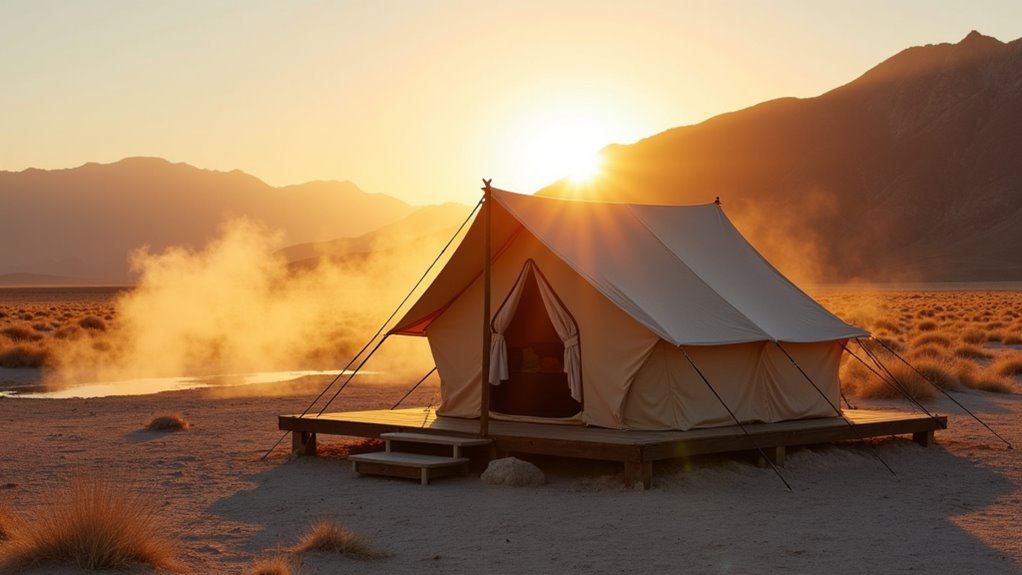
Located in Death Valley National Park, Furnace Creek Campground offers the perfect winter base camp with 136 sites for both RVs and tent campers.
You’ll find essential amenities including flush toilets, potable water, and campfire rings or grills at each site, with full hookups available for RVs. Make sure to book your stay well in advance, as reservations are required 6 months ahead.
While warmer than other Death Valley locations due to its low elevation, you’ll still need to prepare for cold, windy nights.
The campground’s proximity to attractions and superior facilities make it the park’s most popular winter camping destination.
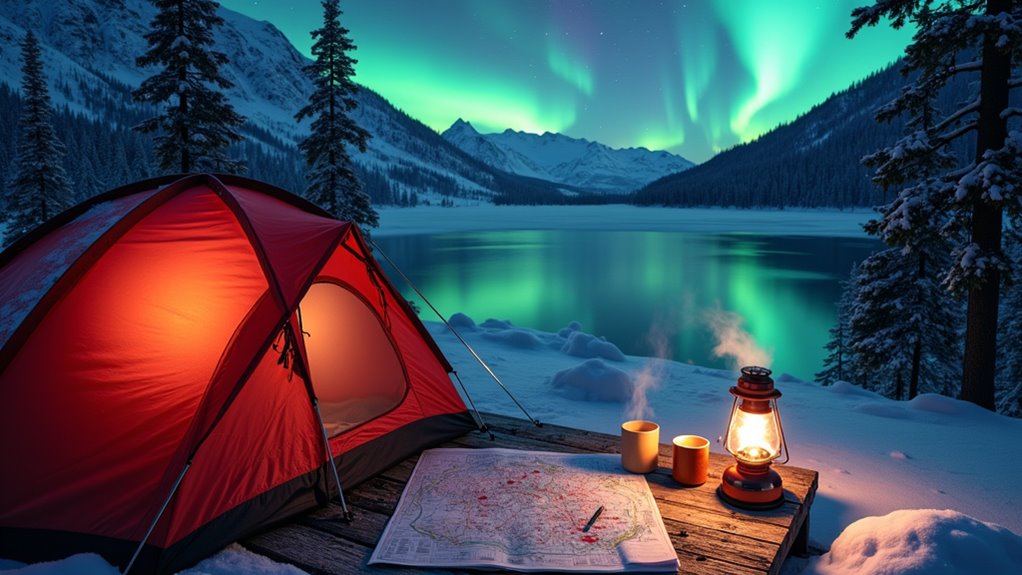
When planning a winter camping adventure, you’ll find numerous destinations across the United States through interactive mapping tools that highlight both warm and cold-weather options.
Tools like CampMap and FreeCampsites.net let you discover locations ranging from sun-soaked Florida Keys to snow-covered Yellowstone backcountry.
Southern destinations offer mild temperatures in the 50s-60s°F, with popular spots including Sedona, South Padre Island, and New Orleans.
These locations combine comfortable camping with nearby attractions like red rock hiking trails, waterfront activities, and cultural festivals.
For snow enthusiasts, northern sites provide true winter camping experiences. Many camping destinations now feature 360° photo tours that provide an immersive preview of winter campsites.
Use interactive maps’ filtering features to check amenities, accessibility, and recent reviews.
Remember to verify winter-specific rules and road conditions before departure, as weather can impact site access and camping regulations.
These winter camping destinations offer you a million stars and endless possibilities for February adventure. You’ll find ideal temperatures, fewer crowds, and pristine landscapes across America’s most spectacular deserts and coastal regions. Whether you’re seeking solitude in Death Valley or dreaming of Monument Valley’s towering buttes, there’s a perfect winter campsite waiting for you. Check the interactive map to start planning your unforgettable February escape.